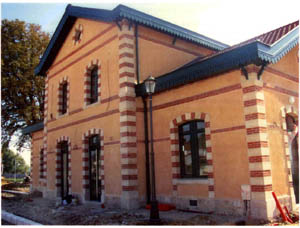HISTORY OF THE
BIG BELT WEST
OF PARIS

After the 1870 defeat and the Prussian invasion,
the French government decided, for strategic reasons, to build a line of military
forts around the capital linked by a railway system called “the Big Belt”
which, in case of war, could carry troops and ammunitions towards fight zones.
It will also improve exchange of goods between the other railway systems,
which at that time, were independent
one from each other. It is also planned
a few passenger trains, mostly in the morning and the evening,
The Big Belt has been built by steps after 1877,
but the West part has been delayed until 1882. It is in a less populated area,
and it requires heavy framework : the tunnel of Relais under the Marly forest, and the viaduct
of Val St-Léger in St- Germain en Laye.
Goods transportation has continued, with ups and
downs, until 1990, but passengers traffic has never been profitable or even
satisfactory. The group responsible for this track, has looked for different
formulas to solve this problem : circular trains all around Paris, “light
trains” or combination tramway-train. They also tried to establish good connections,
mostly with the line St-Lazare-St-Cloud- L’Etang
During World War
1, the track is connected to the military system, and the two junctions of
the Forêt de Marly are suppressed. In 1919, the Big Belt is again autonomous
and the problem of the west area is still the same : few and slow trains,
no connections. In 1929, the big crisis forces to strong decisions, and it
is necessary to stop the passenger traffic which will occur just before World
War 2
From the beginning of the war, the Big Belt became
active again, as it was during World War 1. It has been used in 1940 to carry
refugees, but, alas, also for deportation of Jews and Resistants. The German
troops, in order to have secondary ways to Normandy and Brittany, have reopened
the junctions in Forêt de Marly but they did not forget to blow up the Val
St-Léger viaduct when they were forced by the Allied troops to evacuate the Paris
area.
It is only in 1970, with the appearance or the
big increase of the new cities, that train will come again in perspective.
Noisy le Roi, as other cities, has had a heavy demographic increase, with
a corresponding jump of the car traffic. Creation of cross railways becomes
a necessity. But the 1973 oil crisis will change everything and stop projects.
In 1990, hopes are high for a reopening of the
Noisy station. The direct link Noisy-Marly with a jump-over near l’Etang la
Ville is about to be established. At the
last minute, some residents filed a complaint before the Administrative Court
and blocked everything. The State Council, in its turn, remained silent, despite
constant pressure from elected bodies.
The municipal elections with new teams allowed
to fin a solution : it is necessary to drop the radial connection, and to
reactivate the Big Belt, at the beginning in its section between Noisy le
Roi and St-Germain en Laye, with a train change in St-Nom la Bretêche for
connection to Paris-St-Lazare.
All parties
have agreed, and the first part of a line which, one day, will link Cergy-Pontoise
to St-Quentin en Yvelines and Massy will be opened in December 2004.
___________________